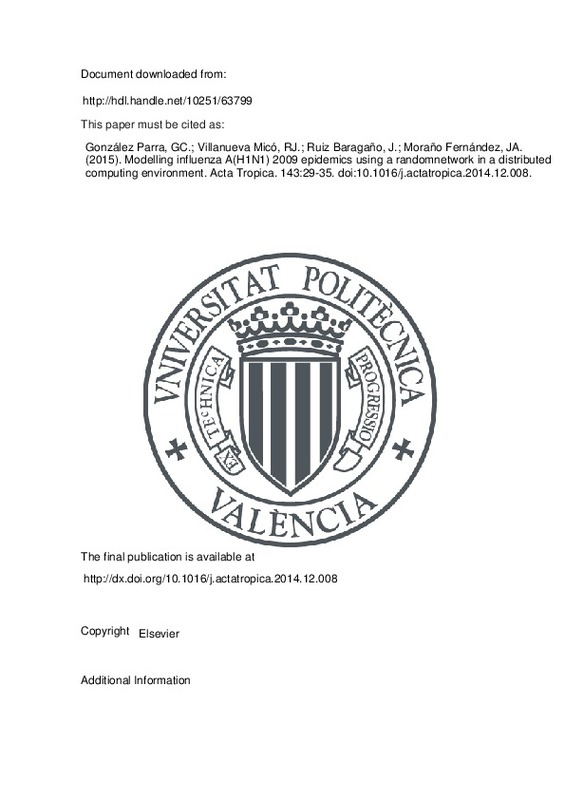JavaScript is disabled for your browser. Some features of this site may not work without it.
Buscar en RiuNet
Listar
Mi cuenta
Estadísticas
Ayuda RiuNet
Admin. UPV
Modelling influenza A(H1N1) 2009 epidemics using a randomnetwork in a distributed computing environment
Mostrar el registro sencillo del ítem
Ficheros en el ítem
| dc.contributor.author | González Parra, Gilberto Carlos
|
es_ES |
| dc.contributor.author | Villanueva Micó, Rafael Jacinto
|
es_ES |
| dc.contributor.author | Ruiz Baragaño, Javier
|
es_ES |
| dc.contributor.author | Moraño Fernández, José Antonio
|
es_ES |
| dc.date.accessioned | 2016-05-09T13:47:14Z | |
| dc.date.available | 2016-05-09T13:47:14Z | |
| dc.date.issued | 2015-03 | |
| dc.identifier.issn | 0001-706X | |
| dc.identifier.uri | http://hdl.handle.net/10251/63799 | |
| dc.description.abstract | In this paper we propose the use of a random network model for simulating and understanding theepidemics of influenza A(H1N1). The proposed model is used to simulate the transmission process ofinfluenza A(H1N1) in a community region of Venezuela using distributed computing in order to accom-plish many realizations of the underlying random process. These large scale epidemic simulations haverecently become an important application of high-performance computing. The network model pro-posed performs better than the traditional epidemic model based on ordinary differential equationssince it adjusts better to the irregularity of the real world data. In addition, the network model allowsthe consideration of many possibilities regarding the spread of influenza at the population level. Theresults presented here show how well the SEIR model fits the data for the AH1N1 time series despitethe irregularity of the data and returns parameter values that are in good agreement with the medicaldata regarding AH1N1 influenza virus. This versatile network model approach may be applied to thesimulation of the transmission dynamics of several epidemics in human networks. In addition, the sim-ulation can provide useful information for the understanding, prediction and control of the transmissionof influenza A(H1N1) epidemics. | es_ES |
| dc.description.sponsorship | First author has been supported by CDCHTA project grant I-1289-11-05-A. Third author acknowledge support from the Universitat Politecnica de Valencia grant PAID-06-11 Ref: 2087. | en_EN |
| dc.language | Inglés | es_ES |
| dc.publisher | Elsevier | es_ES |
| dc.relation.ispartof | Acta Tropica | es_ES |
| dc.rights | Reserva de todos los derechos | es_ES |
| dc.subject | AH1N1/09 influenza epidemic | es_ES |
| dc.subject | Random network model | es_ES |
| dc.subject | Mathematical model | es_ES |
| dc.subject | Distributed computing environment | es_ES |
| dc.subject.classification | MATEMATICA APLICADA | es_ES |
| dc.title | Modelling influenza A(H1N1) 2009 epidemics using a randomnetwork in a distributed computing environment | es_ES |
| dc.type | Artículo | es_ES |
| dc.identifier.doi | 10.1016/j.actatropica.2014.12.008 | |
| dc.relation.projectID | info:eu-repo/grantAgreement/ULA//I-1289-11-05-A/ | es_ES |
| dc.relation.projectID | info:eu-repo/grantAgreement/UPV//PAID-06-11-2087/ | es_ES |
| dc.rights.accessRights | Abierto | es_ES |
| dc.contributor.affiliation | Universitat Politècnica de València. Departamento de Matemática Aplicada - Departament de Matemàtica Aplicada | es_ES |
| dc.contributor.affiliation | Universitat Politècnica de València. Instituto Universitario de Matemática Multidisciplinar - Institut Universitari de Matemàtica Multidisciplinària | es_ES |
| dc.description.bibliographicCitation | González Parra, GC.; Villanueva Micó, RJ.; Ruiz Baragaño, J.; Moraño Fernández, JA. (2015). Modelling influenza A(H1N1) 2009 epidemics using a randomnetwork in a distributed computing environment. Acta Tropica. 143:29-35. https://doi.org/10.1016/j.actatropica.2014.12.008 | es_ES |
| dc.description.accrualMethod | S | es_ES |
| dc.relation.publisherversion | http://dx.doi.org/10.1016/j.actatropica.2014.12.008 | es_ES |
| dc.description.upvformatpinicio | 29 | es_ES |
| dc.description.upvformatpfin | 35 | es_ES |
| dc.type.version | info:eu-repo/semantics/publishedVersion | es_ES |
| dc.description.volume | 143 | es_ES |
| dc.relation.senia | 294924 | es_ES |
| dc.contributor.funder | Universidad de los Andes, Venezuela | es_ES |
| dc.contributor.funder | Universitat Politècnica de València | es_ES |







![[Cerrado]](/themes/UPV/images/candado.png)

